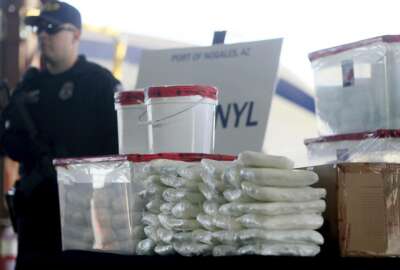
IG warns customs officers intercepting fentanyl at risk of exposure
Best listening experience is on Chrome, Firefox or Safari. Subscribe to Federal Drive’s daily audio interviews on Apple Podcasts or PodcastOne. The amount of...
Best listening experience is on Chrome, Firefox or Safari. Subscribe to Federal Drive’s daily audio interviews on Apple Podcasts or PodcastOne.
The amount of fentanyl needed to kill a person is barely enough to cover up the date on the face of a penny. Yet the workers responsible for intercepting and disposing of the drug when it attempts to enter the country are not adequately protected from its exposure.
This disturbed the Department of Homeland Security’s Office of the Inspector General so much that it issued a management alert before publishing a full report.
“It’s 80 to 100 times stronger than morphine, and 30 to 50 times more potent than heroin. It only takes two milligrams of fentanyl to kill most individuals,” Donald Bumgardner, deputy assistant inspector general for audits, told Federal Drive with Tom Temin.
Fentanyl is a synthetic opioid made as a medically prescribed drug to treat pain, and can take the form of a shot, patch or lozenges. But when made illegally, the drug is usually sold as a powder, dropped onto blotter paper, put in eye droppers and nasal sprays, or made into pills that resemble other prescription opioids, according to the National Institute on Drug Abuse.
It’s the Customs and Border Protection Officers handling the drug that are at the greatest risk, but the agency has not updated its handbook on dangerous substances in eight years. Bumgardner said the OIG was concerned fentanyl is being stored incorrectly, and that not all CBP facilities had naloxone available. The medication is highly reliable at countering the effects of an opioid overdose and can be administered via injection or in a nasal spray such as NARCAN.
During a recent audit, Bumgardner said his office found that two of seven CBP vaults containing fentanyl did not have naloxone, two had the drug but it was locked with codes unknown to the CBP officer. These seven vaults were out of 62, which the OIG decided was enough to send an alert to all CBP staff about proper training.
But so far, Bumgardner said, DHS is aware of three cases of CBP employees being administered naloxone for suspected fentanyl exposure, though two of those cases turned out to be other opioids.
Aside from storage, proper handling of fentanyl is crucial during the transport from the point of entry at which CBP officers confiscated the drug.
“What I can say is that CBP’s seized asset management and enforcement procedures handbook for daily operations of the vaults does not include specific procedure for managing fentanyl. That was particularly concerning to us,” Bumgardner said. “So the procedures were last updated in July 2011. And CBP does not require mandatory training for staff to demonstrate an understanding of the risks of fentanyl, and methods for combating accidental exposure.”
Fentanyl-related deaths have skyrocketed. The rate of overdose deaths from synthetic opioids other than methadone — most of which are fentanyl or fentanyl analogs — increased from 1 in 100,000 people in 2013, to 9 in 100,000 in 2017, according to the National Center for Health Statistics.
Bumgardner said the OIG recommended CBP revise its asset management and enforcement procedures handbook to include guidance on handling and storing opioids such as fentanyl. At a minimum, he said, naloxone should be available to all employees at facilities and in vehicles involved in its seizure, transportation and storage, not to mention training on administering naloxone.
“CBP concurred with our recommendations and on June 24, 2019, CBP’s executive assistant commissioner for OFO issued a memorandum entitled ‘Naloxone Distribution and Training for Seizure Vault Personnel.’ This memo directed that all OFO permanent vaults be equipped with naloxone nasal spray kits and lock boxes, and that individuals be trained on proper use of the spray and understanding of the hazards of fentanyl and methods to combat accidental exposure,” Bumgardner said.
The estimated completion date for those changes is Sept. 30, and he said the OIG “definitely” plans to follow up on them.
Copyright © 2025 Federal News Network. All rights reserved. This website is not intended for users located within the European Economic Area.



